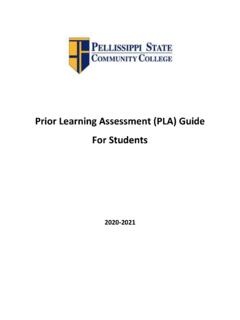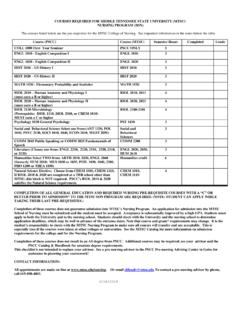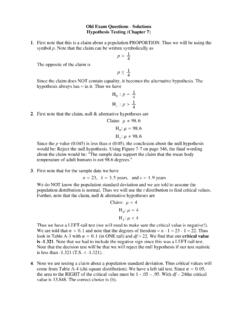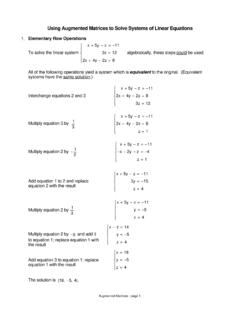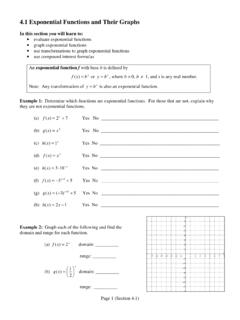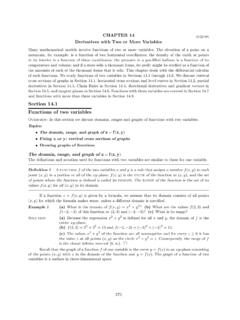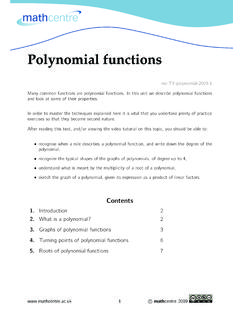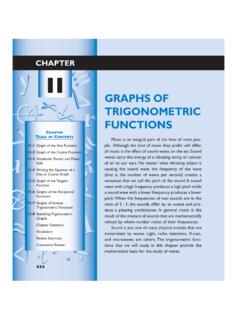Transcription of Trigonometry Review with the Unit Circle: All the trig ...
1 Trigonometry Review with the unit Circle: All the trig. you'll ever need to know in Calculus Objectives: This is your Review of Trigonometry : angles, six trig. functions , identities and formulas, graphs: domain, range and transformations. Angle Measure Angles can be measured in 2 ways, in degrees or in radians. The following picture shows the relationship between the two measurements for the most frequently used angles. Notice, degrees will always have the degree symbol above their measure, as in 452 , whereas radians are real number without any dimensions, so the number 5 without any symbol represents an angle of 5.
2 Radians. An angle is made up of an initial side (positioned on the positive x-axis) and a terminal side (where the angle lands). It is useful to note the quadrant where the terminal side falls. Rotation direction Positive angles start on the positive x-axis and rotate counterclockwise. Negative angles start on the positive x-axis, also, and rotate clockwise. Conversion between radians and degrees when radians are given in terms of .. DEGREES RADIANS: The official formula is D = radians 180D. 2 . Ex. Convert 120D into radians SOLUTION: 120D D. = radians 180 3. 180D. RADIANS DEGREES: The conversion formula is radians = D.
3 180D 180D. Ex. Convert into degrees. SOLUTION: = = 36D. 5 5 5. For your own reference, 1 radian A radian is defined by the radius of a circle. If you measure off the radius of the circle, then take the straight radius and curved it along the edge of the circle, the angle this arc marks off measures 1 radian. Arc length: when using radians you can determine the arc length of the intercepted arc using this formula: Arc length = (radius) (degree measure in radians). OR. s = r There may be times you'll use variations of this formula. Ex. Find the length of the arc pictured here: SOLUTION: s = r you know the values of r and.
4 5 25 . s = 5 = units for the arc length. 4 4. The Trigonometric Ratios The six trigonometric ratios are defined in the following way based on this right triangle and the angle . adj. = adjacent side to angle . opp. = opposite side to angle . hyp. = hypotenuse of the right triangle opp. adj. opp. SOH CAH TOA sin = cos = tan =. hyp. hyp. adj. hyp. hyp. adj. Reciprocal functions csc = sec = cot =. opp. adj. opp. Ex. Find the exact values of all 6 trigonometric functions of the angle shown in the figure. SOLUTION: first you'll need to determine the 3rd side using a 2 + b 2 = c 2 a 2 + 52 = 132 a = 12. So for the angle labeled , ADJACENT = 12, OPPOSITE = 5 and HYPOTENUSE = 13.
5 Opp 5 adj 12 opp 5. sin = = cos = = tan = =. hyp 13 hyp 13 adj 12. hyp 13 hyp 13 adj 12. csc = = sec = = cot = =. opp 5 adj 12 opp 5. Special Angles The following triangles will help you to memorize the trig functions of these special angles . 30D = 60D = 45D =. 6 3 4. If the triangles are not your preferred way of memorizing exact trig. ratios, then use this table. D RAD sin cos tan csc sec cot . 1 3 3 2 3. D 2. 30 6 2 2 3 3 3. 2 2. D 1 1. 45 4 2 2 2 2. 3 1 2 3 3. D 2. 60 3 2 2 3 3 3. but even better than this is the unit circle. The trig. ratios are defined as . sin t = y cost = x y tan t = ,x 0. x 1. csc t = , y 0.
6 Y 1. sec t = , x 0. x x cot t = , y 0. y Domain and Period of Sine and Cosine Considering the trigonometric ratios as functions where the INPUT values of t come from values (angles) on the unit circle, then you can say the domain of these functions would be all real numbers. Domain of Sine and Cosine: All real numbers Based on the way the domain values can start to cycle back over the same points to produce the same OUTPUT over and over again, the range is said be periodic. But still, the largest value that sine and cosine OUTPUT on the unit circle is the value of 1, the lowest value of OUTPUT is 1. Range of Sine and Cosine: [ 1 , 1].
7 Since the real line can wrap around the unit circle an infinite number of times, we can extend the domain values of t outside the interval [0, 2 ] . As the line wraps around further, certain points will overlap on the same ( x , y ) coordinates on the unit circle. Specifically for the functions sine and cosine, for any value sin t and cos t if we add 2 to t we end up at the same ( x , y ) point on the unit circle. Thus sin(t + n 2 ) = sin t and cos(t + n 2 ) = cos t for any integer n multiple of 2 . These cyclic natures of the sine and cosine functions make them periodic functions . Graphs of Sine and Cosine Below is a table of values, similar to the tables we've used before.
8 We're going to start thinking of how to get the graphs of the functions y = sin x and y = cos x . x 0 3 3 2 . 6 4 3 2 4 2. y = sin x 0 2. 3. 1 2. 0 1 0. 2 2 2. y = cos x 1 0 1 0 1. 2. 3. 2. 2. 2. 2. Now, if you plot these y-values over the x-values we have from the unwrapped unit circle, we get these graphs. One very misleading fact about these pictures is the domain of the function remember that the functions of sine and cosine are periodic and they exist for input outside the interval [0, 2 ] . The domain of these functions is all real numbers and these graphs continue to the left and right in the same sinusoidal pattern.
9 The range is [ 1,1] . Amplitude When the sine or cosine function has a coefficient in front, such as the value of a in the equation y = a sin x or y = a cos x , this causes the graph to stretch or shrink its y-values. This is referred to as the amplitude. Ex. Compare the graphs of y = cos x y = 2 cos x y = 21 cos x y = 2 cos x amplitude = 1 amplitude = 2 amplitude = amplitude = 2. with reflection in x-axis Amplitude is an absolute value quantity. When the coefficient is negative, this causes an x-axis reflection. Period If there is a coefficient within the argument in front of the x , this will change the length of the function's period.
10 The usual cycle for sine and cosine is on the interval 0 x 2 , but here's how this can change . Let b be a positive real number. The period of y = a sin bx and y = a cos bx is found this way: 2 . 0 bx 2 divide by b 0 x . b NOTE: If b > 1 , this will cause the graph to shrink horizontally because the period will be less than 2 . If 0 < b < 1 , the graph will stretch horizontally making the period greater than 2 . You'll need to adjust the key points of the graph when the period changes! Key points are found by dividing the period length into 4 increments. Ex. Sketch a graph of y = 2sin ( 14 x ) by hand. SOLUTION: The coefficient a = 2 will effect the range of the graph .

